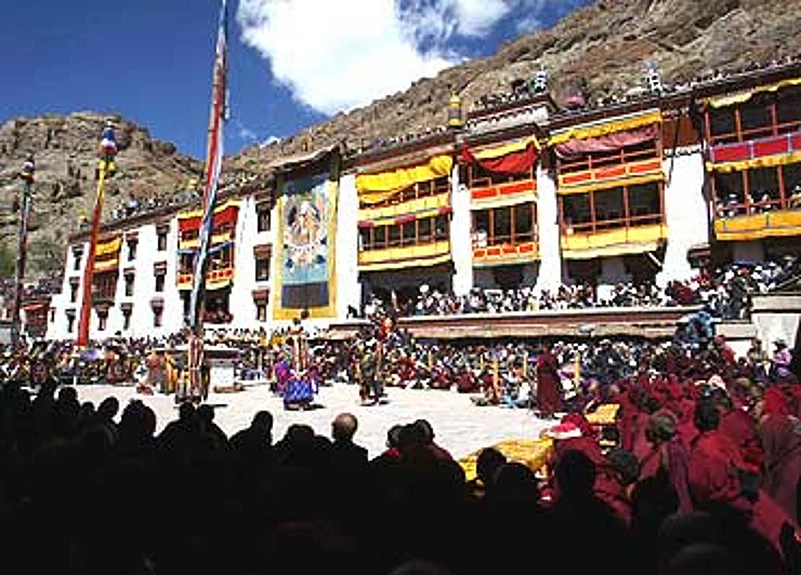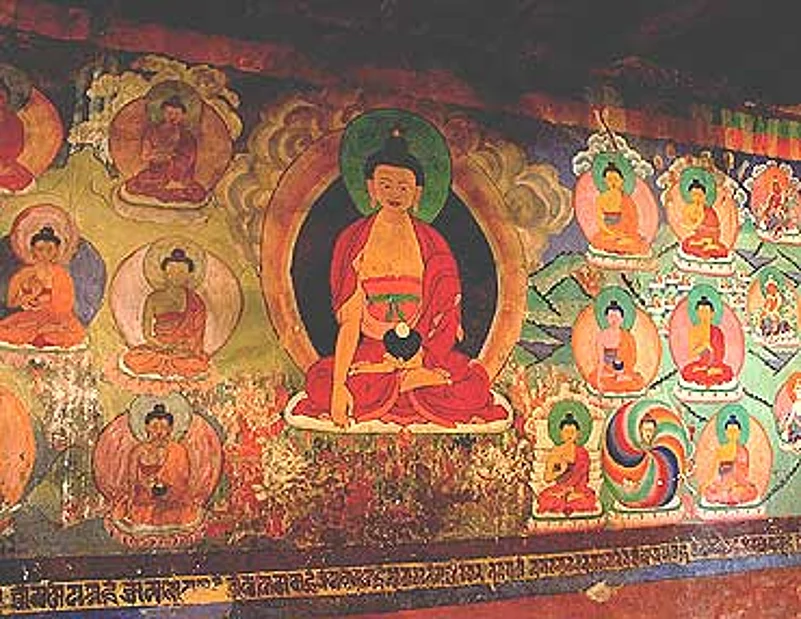Touch Of Synthetic
***
It's autumn, the poplars and willows are a brilliant gold, and the 17th-century Hemis monastery, tucked into a side valley of the Zanskar range, some 45 km east of Leh, looks most inviting. But visitors are not welcome at Ladakh's richest and most famous monastery nowadays. The once grand Dukhang or the main prayer hall is in a royal shambles. Two floors have been demolished, the priceless statues and 'thangkas' are in storage, and the outside world knows almost nothing about the fate of the beautiful old murals that used to adorn the inside walls of this famous heritage structure.
Fixing blame is a messy business because this calamitous turn of events capped a long story of conflict. At one level, it was the handiwork of the monks acting suo motu. But the fact is it happened in a monument protected by the Archaeological Survey of India, right under its nose, and calls into question its very approach to heritage in Ladakh.

The Hemis monastery as it is used to be
The demolition at Hemis is also only the sharpest symptom of a general malaise. Agitated conservationists accuse the ASI of being ineffectual and negligent, and failing to build bridges with Ladakh's powerful Buddhist clergy. The clergy too doesn't necessarily work in conformity with heritage renovation principles. And the breach between the two sides is so bad at Hemis that the monks haven't even let ASI officials into the premises since 2006! The reasons are fairly typical: the monks wanted to build a new museum building on the periphery of the courtyard; the ASI objected. In the wake of that breakdown of diplomacy, the core itself stands scarred.
"This is all the result of the ASI's casual attitude towards monasteries in Ladakh," says Saleem Beg, convenor, INTACH's J&K chapter, who first discovered the demolition at Hemis this July. "It has lost the confidence of the monks with its shoddy, ad-hoc repair work. In Hemis, and other monasteries too, there is much animosity between the ASI and the clergy, leading to wanton destruction of traditional Ladakhi architecture and paintings."
Earlier this year, the parliamentary standing committee on tourism and culture, led by Sitaram Yechury, visited Hemis where the monks showed them the shoddy repair work the ASI had done on the Dukhang's roof. It had aggravated the leakage, threatening imminent collapse. The panel asked the ASI representative there to allow the monks to repair the monastery on their own and to make an expert conservationist available to them. As Beg pointed out in an anguished letter to the ASI director-general, "When I reached there with a conservation architect, I found to my horror some 30 labourers demolishing the upper floor of the monastery. This was being done under the supervision of a village mason."
Tsewang Rigzin, a senior monk at Hemis and also secretary of its managing committee, invokes the fraught issue of ownership of heritage: "Repair and renovation of our monasteries is an ongoing process since we live and pray in them. Whenever we request the ASI to do it for us, we find it never goes to the root of the problem. It does nothing to preserve the murals either."
At the 11th-century Lamayuru monastery, the oldest in central Ladakh, a new four-storey structure obstructs the view of the old. The renovation efforts of the resident monks at the 15th-century Thiksey monastery have resulted in the traditional mud-and-stone courtyard being covered with granite, the construction of a new kitchen and dining hall for the monks, and the demolition of the old structure in the central courtyard to make way for a new temple. All the new elements are jarring, wrecking the harmony of the old structures. In defence, Thiksey's secretary, Lobsang Thapkas, goes on the offence: "ASI officials do not consult us and think they know best. This is not always so. They have repaired the ancient 10th century king's palace in our monastery so shoddily, the windows have no resemblance to the earlier ones." At Matho monastery, a cement mixer sits bang in the middle of the central courtyard, where a new steel-and-concrete 'lakhang' (chapel) is under construction.

Jarring brightness: A mural at the Thiksey monastery, the right side of which has been 'restored'
Ladakh attracts a large number of tourists, researchers and scholars drawn by its centuries-old mud-and-stone monasteries with their distinctive architecture and murals. But indiscriminate and ham-handed modernisation efforts are destroying the heritage character and status of several monasteries. The few under ASI protection are issued notices in a routine manner whenever a violation of the Ancient Monuments and Archaeological Sites and Remains Act, 1958, is noticed. "Unfortunately," says Thubstan Chewang, Lok Sabha MP from Ladakh, "the monks have never trusted the ASI and resent its interference in what they feel is their property. The ASI, facing shortage of resources and manpower, has not been able to do quality work. The ASI needs to be more proactive in taking the monks along with them."
With growing tourism, Ladakh's gompas are flush with money. Resident monks thus prefer to do their own renovation rather than rely on a cash-strapped ASI. And with younger monks dazzled by modern construction materials and methods, the outcome is disastrous. Often, the first casualty are the thick sloping walls made of rammed earth, characteristic of all traditional monasteries. They yield to cement structures, exquisite old murals painted in earth colours give way to garish ones in enamel paint, and old flagstones and wooden floors cede ground to marble, out of place in this cold climate. As Beg points out, "Even with the best intentions, the monks just do not have the expertise to renovate according to traditional design. They depend on government engineers or village masons who have no idea of architectural conservation. Hemis could have been saved had a conservation architect been allowed to work on it." As for ASI, its superintending archaeologist at Jammu, R. Krishnaiah, can only wring his hands, saying, "In this stand-off between us and Hemis, a monument of national importance shouldn't suffer. I'm ready to cooperate and resolve the matter." But it may already be too late.


























